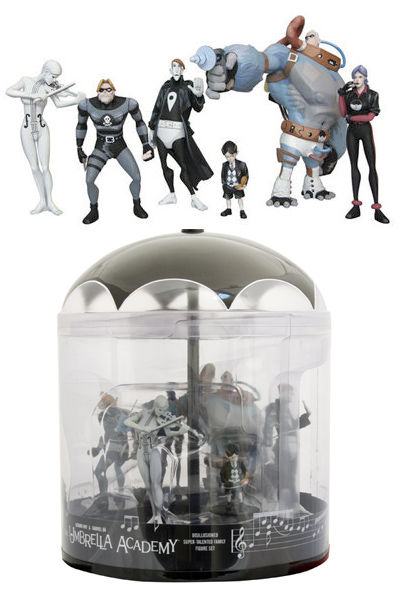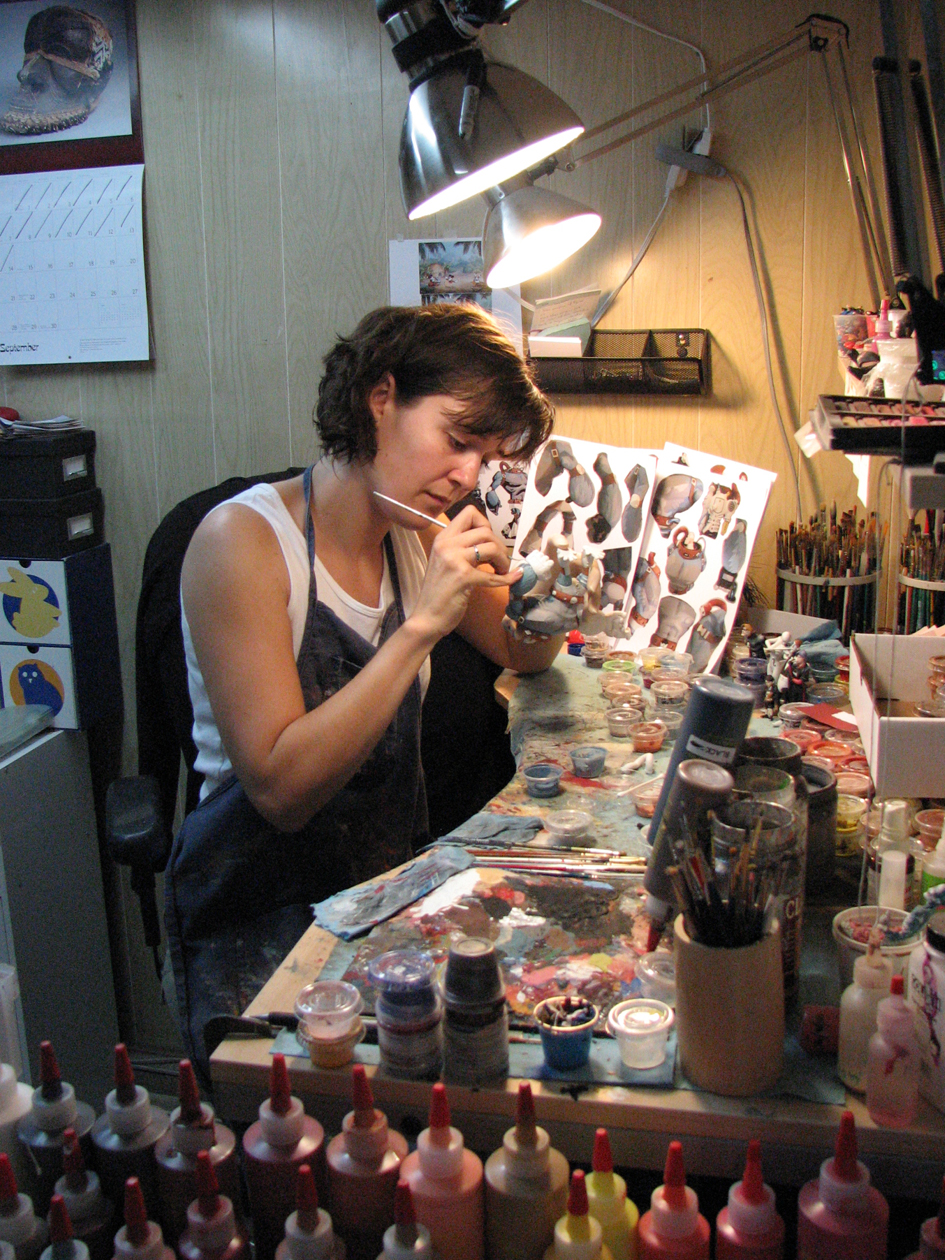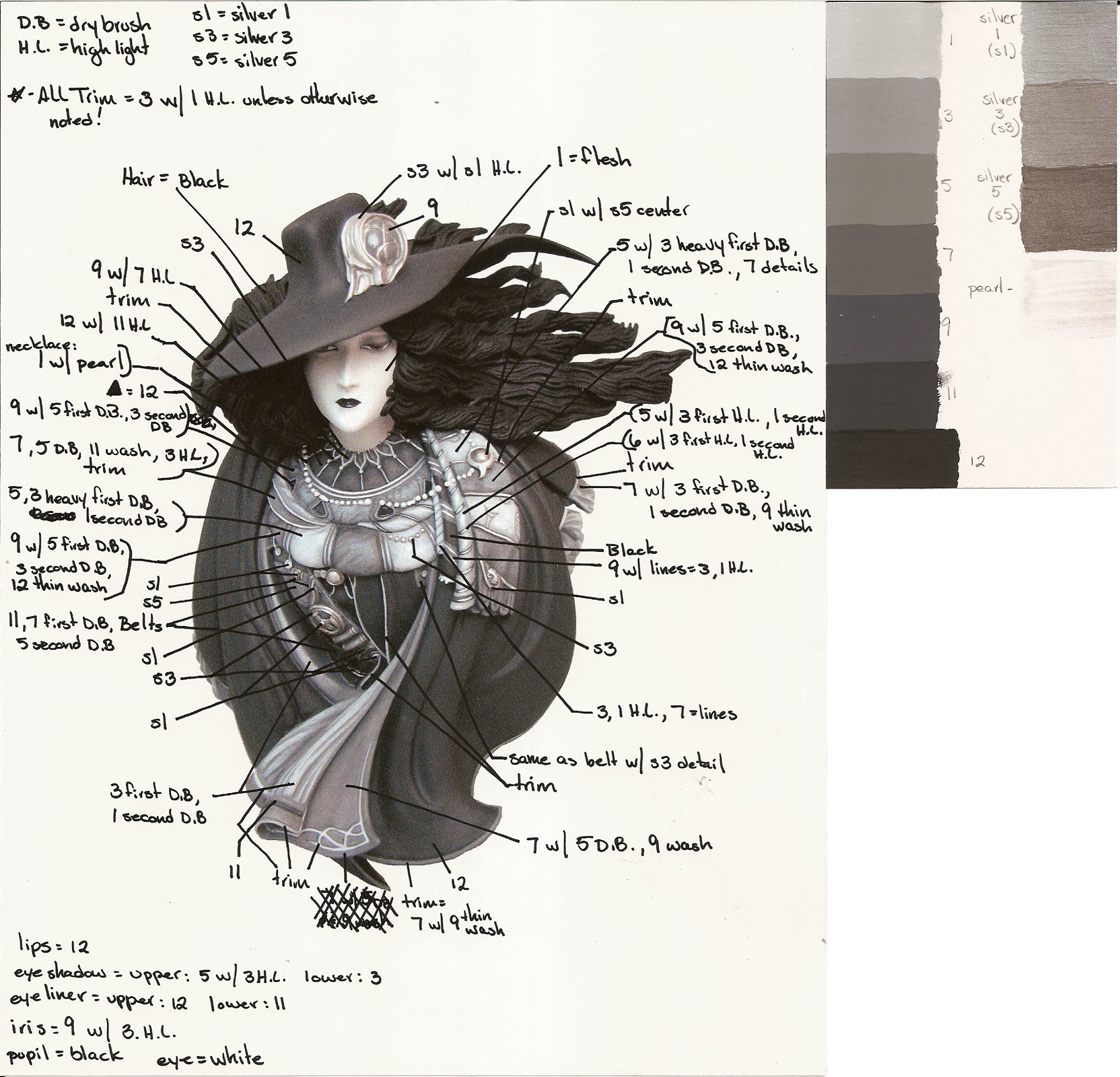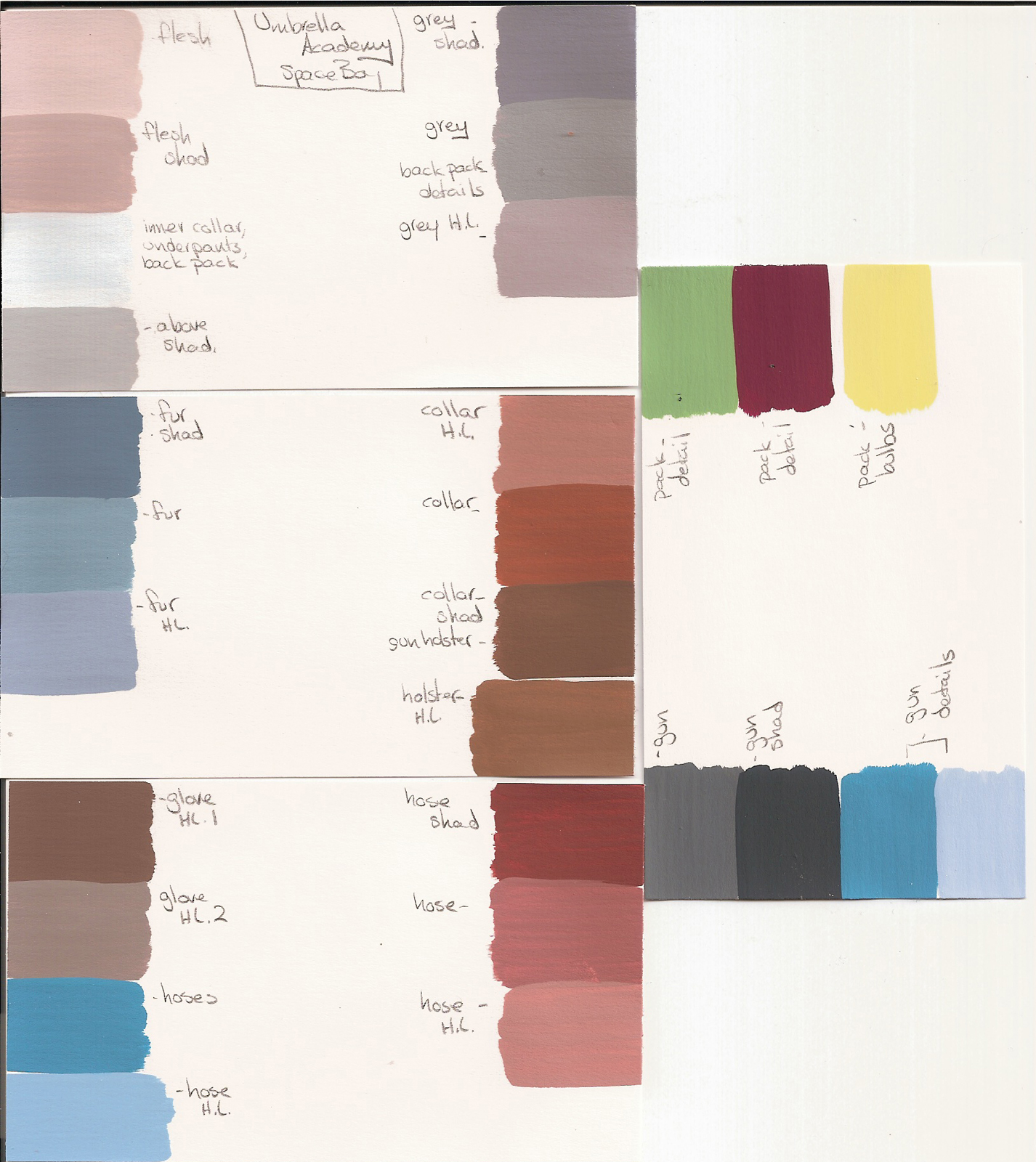 That David Scroggy is at it again! And we’re bringing you another special interview conducted by Dark Horse’s V.P. of Product Development. In the last David Scroggy interview we looked at the art of sculpting, now we’re moving on the to painting process with Kat Sapene, one of the top creators in her field.
That David Scroggy is at it again! And we’re bringing you another special interview conducted by Dark Horse’s V.P. of Product Development. In the last David Scroggy interview we looked at the art of sculpting, now we’re moving on the to painting process with Kat Sapene, one of the top creators in her field.Sapene has worked on several Dark Horse projects and has more on the way, so keep a look out for all the great items from Dark Horse Deluxe.

(Sapene works on Spaceboy, part of the upcoming Umbrella Academy PVC set.)
David Scroggy: Were you interested in toys and comics as a child? Were any of the things that captured your fancy inspirational?
Kat Sapene: More than anything I was really into cartoons when I was a kid. If I wasn’t outside playing in the dirt with my Snoopy doll, I was inside watching old Warner Bros. and Disney shorts. I grew up wanting to be an animator; I thought that would be the coolest job ever! So I spent any time I wasn’t watching cartoons drawing (mostly just tracing cartoon characters) and painting so I would be ready when I grew up. As it turned out, all that tracing came in pretty handy. After college, I was hired at an animation studio in New York, Curious Pictures, to work as an inker. Which is pretty much skilled tracing, but I loved it.??
DS: Did you go to art school, Kat?
KS: Actually, I did not go to art school. I went to a small liberal arts college in Ohio, Oberlin College. I couldn’t decide if I wanted to go into art or physics so I went somewhere I could pursue both. But eventually, the physics labs and the arts classes started to get in the way of one another and I had to make a decision. I ended up with a major in Visual Arts and more math classes than you can shake a stick at!
I also enhanced my education in the summers with life drawing and animation classes at the School of Visual Arts in New York.??
DS: What got you into this line of work? Prototype painting seems to be a?highly specialized area. What led you to it?
KS: Animation! It’s amazing to me how many people meant to work in animation and ended up making toys. Just read Tony’s interview for proof!
While I was at Curious Pictures, I met a guy who was starting up his own prototyping studio in Hoboken, New Jersey. He let me try my hand at painting the prototypes, and the next thing I knew I was working at his studio on the weekends. Eventually I made the difficult decision to leave animation. I realized I was miserable just working on storyboards, since all the animating is done overseas these days. But I also knew that I was much happier when I was painting on the weekends. So I took painting classes at the Art Students’ League in New York and worked hard learning to use an airbrush and how to paint clean lines. All that inking work turned out to be pretty helpful! Luck and hard work, that’s what it all amounts to.
DS: Do you do any original painting or sculpture?
KS: Not really. I’ve done a little sculpting for some toys, but not much personal work. Part of why I left animation is because I can’t draw. Minor problem when animating . . .
DS: Are you given a lot of direction, or are you able to bring your own choices to a typical piece?
KS: It really depends on the projects and the client. Sometimes when I’m painting certain characters, like Spider-Man or Sponge Bob, there are specific colors that I have to use. But most of the time, I’m given the reference and it’s up to me to make it happen. Not that I’m always given reference. Normally I will consult with a client to make sure we are on the same page as to the style of the paint. Are we trying to make the piece realistic, like Bettie Page; hard-edged shadows and highlights, like with the Umbrella Academy PVCs; or do we want to use an airbrush to create depth, like with Glenn Barr’s Hell’s Proprietor? What I don’t want to do is surprise anyone with what I’m doing. By the time a piece is in my hands, we are either very close to the deadline, or the deadline has been . . . extended.



DS: When you complete the prototype, are you asked to create guides or a?step-by-step instruction sheet for the manufacturer?
KS: More and more clients are asking me to make “color call-outs” for them. This involves making color swatches of all the colors used and labeling them; sometimes adding the paint technique that was used. At times this can be simple, mostly just swatches as it is clear what goes where, like with Spaceboy. And sometimes it can look like a medical diagram, like the monochrome version of the Vampire Hunter D bust. Each little area has its own series of steps used to create the effect we’re looking for.
The goal is to cut out any potential for errors at the factory. Anything and everything helps.

DS: Are there any particular materials that you like to use?
KS: I like to use animation cel-vinyl to paint my projects. It’s very similar to acrylic paints. But because it was meant to be used to paint animation cels (the individual frames that make up cartoons), the paint is very opaque. This means fewer layers of paint that need to be applied and therefore I don’t have to worry about paint buildup distorting the original sculpt. Aside from being opaque, cel-vinyl dries quickly, keeps its color over time, and is slightly flexible. The flexibility allows for handling without much chipping. And the paint is very versatile. It can be used for a wash, a dry brush, or even through an airbrush. I love it!
When I first moved out to LA, I was so excited to go to the place where they make my cel-vinyl, and where I had been ordering it for years, that I forgot to put a quarter in the parking meter. Best thirty-six dollars for parking I’ve ever spent!
DS: Do you ever find yourself enhancing the sculpture with color? Do?sculptural details influence how you choose and apply color?
KS: Absolutely. It’s what I’m here for. I’m here to show off the assets of a sculpt and to downplay the less fabulous parts. But no matter what I do, the final product is all about the sculpt, not the paint job. A successful paint job is one you don’t see. And by this I mean that the paint job doesn’t overwhelm the original sculpt. So any adjustments I’ve made shouldn’t be noticeable; it’s all part of the sculpt.
DS: Has there ever been a job you have refused? Why?
KS: I think I may have refused five or six jobs in my nine years painting toys. And all of them were just because it was physically impossible to fit the projects into my schedule.
The way this industry works, you are either very busy or not busy at all. So you take all the jobs you can handle when they are offered up to you. But you have to know how much work you can handle.??
DS: Do you think color creates mood, emotion, or drama on a statue?
KS: Absolutely! I’m working on a piece right now that is all about mood and drama in the paint job. I can’t really go into what the project is, but my job is to make the scene look like it’s taking place at sunset. So there is some pretty dramatic lighting that I have to manufacture with the paint.
The colors used to paint a project can take a piece from being a chunk of painted resin to being a miniature bust of a specific actor or a comic character come to life. It’s the difference between “Well, it’s brown so I guess that’s a piece of wood,” and “Wow, did they actually use real wood to make that?” I feel a real sense of accomplishment when I can confuse people like that.??
DS: Having worked on so many different types of pieces for so many companies, do you have a feel for current trends in this area of collecting?
KS: Maybe? It’s really hard to say. I mean, there are things that I work on for other companies that I couldn’t tell you who would buy it. Not that it’s not well done; it’s the subject matter that’s baffling. But most of the times these are the things that do very well. And then there are projects that I’m certain will sell out and . . . nothing. The project is a total bomb.
I just try to paint everything as best I can so everything has a fair chance of success.
DS: What about the trend of color variants? This is mostly in the art vinyl toy genre, but we are seeing it in statues now as well.
KS: I happen to like color variants. But I think it should make sense with the character and subject. Like the variant Vampire Hunter D bust we did. I thought that was awesome! Completely different from the original. But then there are variants where the change is simply different eye color or something. That seems pretty silly.
DS: Have you ever gone to China to observe the manufacturing process?
KS: No, but if anyone would like to sponsor a trip for me I would love to go!??
DS: How do you think color influences our environment, at least the man-made part of it?
KS: Color has a huge influence in the world around us. I mean, there is a reason hospitals are all painted stark white. It gives us a feeling of cleanliness and sterility.
And this is true in the natural world too. The area where I went to school in Ohio was one of the dreariest places I’ve ever spent any length of time in. It got cloudy in September and then you didn’t see the sun again until May! No joke. Professors would let out class on the rare occasion that the sun came out for the day. It was remarkably depressing. But now I live in LA where it’s sunny every day! And that’s a little creepy on its own . . .
DS: Do you use models or reference?
KS: I use a lot of reference. I spend a number of hours per project doing research for reference and just getting to know the subject. Sometimes this takes a couple hours and sometimes it takes me more than a day. It just depends on the quality of the reference I have. But this has allowed me to amass a rather large library of DVDs. I have almost all the major Disney movies. And lots of comic books, too! Working in toys is a great excuse for buying all sorts of things I’ve always wanted.
DS: What are some of your favorite projects? Why?
KS: My favorite projects are the ones that really challenge me and push my skills to their limits. Otherwise things can get a little stagnant. But I have to say that I’ve been lucky enough to work on such a wide range of projects that I am never bored.
One of my favorite projects recently was the Umbrella Academy PVCs. The color palette in that comic is beautiful. And since we decided to use hard-edged shadows for those it really challenged my design abilities.

Another project I really enjoyed working on was Frazetta’s Sun Goddess for ReelArts. Tony Cipriano did a beautiful job sculpting that piece. And the challenge to match the original Frazetta painting while making something that was producible was a lot of fun!

Thanks for chatting with me!